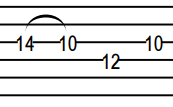I thought Igor Paspalj was a textbook USX player. He does Yngwie covers and appears to play the licks the same way Yngwie does. His setup looks a lot like Yngwie too. Very visual downward slant (and yeah yeah I know the slant doesn’t always mean what it looks like) and I see lots of that forearm ‘wiggle’ we’re used to seeing in a rotational mechanic but more than that to me it just looks like his pick escapes on the upstrokes.
The reason I mention all this is because I thought it would be fun to make myself learn one of his songs (Full Throttle), so I bought the lesson from JTC. To my surprise, there are quite a few phrases he plays that aren’t USX…or DSX. I can’t figure out how he’s doing it though because again, his playing looks like USX to me. I have to be wrong, that’s the only thing that makes sense. Also, it’s a very possible explanation since I’m wrong all the time 
For example, he has this fast descending run here:
And the tabs in the lesson say it’s played like this:
I’m pretty confident the tabs are correct (here and in all examples I’ll post).
Same sort of pattern here:
This one isn’t quite queued up…he does a fast ascending Yngwie one string sequence, but then follows it up with a descending run that poses the same escape problems as the first phrase. So, the second measure here:
Clearly a mixed escape lick (and sequentially almost identical to the first example). I know I’m not imagining that he can do USX, because the very begging of the video is just a repeated 2nps pentatonic lick.
He’s clearly starting each string with a downstroke too. Doesn’t get much more USX than that.
Plus he does lots of 2 string economy picked licks, a la Rising Force or Trilogy that would require USX:

He starts those with an upstroke, so definitely USX.
So what’s he doing, in CtC terms, to allow him to play the mixed escape licks from his Yngwie posture? What’s the helper motion?











